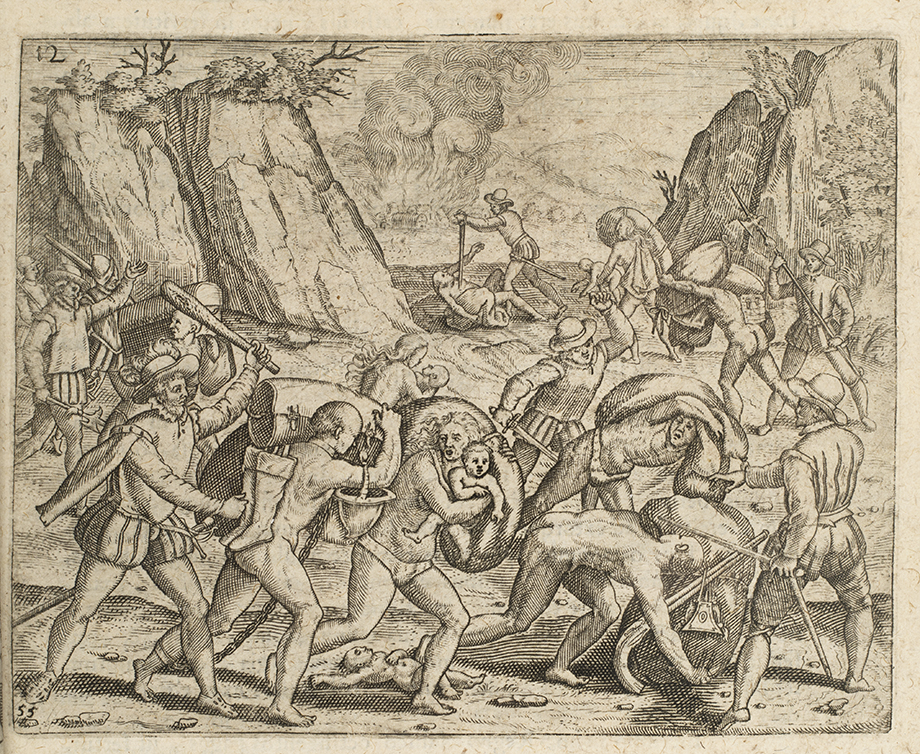Home / Early Encounters, 1492-1734 / Spanish Colonies / Life in Encomienda
Resource
Life in Encomienda
This 1522 illustration of the horrors of the encomienda system highlights the way women and children were particularly vulnerable to abuse by Spanish enslavers.
Note to Teachers: This resource addresses sexual assault and physical violence.
- About
-
Curriculum
- Introduction
-
Units
- 1492–1734Early Encounters
- 1692-1783Settler Colonialism and the Revolution
- 1783-1828Building a New Nation
- 1828-1869Expansions and Inequalities
- 1832-1877A Nation Divided
- 1866-1898Industry and Empire
- 1889-1920Modernizing America
- 1920–1948Confidence and Crises
- 1948-1977Growth and Turmoil
- 1977-2001End of the Twentieth Century
- Discover
-
Search
Background
The spread of Catholicism was the stated goal of the Spanish conquest of the Americas, but the Spanish also wanted to profit from their new territories. Once the treasures of Indigenous civilizations were looted, colonists turned to mining and plantation farming to make their fortunes, and they needed to find cheap labor to maximize their profits. In her early instructions for the governance of the colonies, Queen Isabella I of Spain required all Indigenous people to pay tribute to the crown or its representatives. The encomienda system was created as a result of this directive.
In this system, encomenderos were awarded the control of all the Indigenous people who lived in a defined territory and did not convert to Christianity. This power was usually awarded in recognition of special services to the crown. For example, as recognition for his conquest of the Aztec Empire, conquistador Hernán Cortés was awarded an encomienda territory that included 115,000 Indigenous inhabitants. Hernán’s power over the Indigenous people in his territory was practically absolute. He could demand tribute in the form of crops or currency. He could force them to construct forts and towns and work the mines and plantations. He could sexually exploit the women, and even sell the people who worked for him to other encomenderos. The horrors of life on the encomiendas would eventually spark outrage back in Spain.
About the Image
Bartholomé de las Casas first arrived in the Americas in 1502. He was part of one of the early waves of the Spanish invasion. Bartholomé was rewarded with an encomienda for his services to the crown. Over time, he grew horrified by the outrageous abuses suffered by Indigenous people under the encomienda system. In 1515 he gave up his own encomienda and began a campaign to end the system. This illustration comes from A Short Account of the Destruction of the Indies, Bartholomé’s firsthand account of the abuses he witnessed. Published in 1542, the illustrations were intended to shock readers.
This illustration centers the suffering of women and children. It also hints at the sexual exploitation Indigenous women experienced at the hands of their enslavers.
Bartholomé’s work outraged readers in Spain and prompted the Spanish government to pass the New Laws in 1542. The New Laws aimed to free all Indigenous people from the encomienda system within a generation. This was not a definitive end to the exploitation of Indigenous people in the Spanish colonies, but it was an important step in addressing their oppression.
Vocabulary
- Catholicism: A Christian religion that is led by the pope in Rome.
- conquistador: The name for the Spanish or Portuguese military leaders who conquered Central and South America in the 1500s.
- encomenderos: The name for people who controlled encomiendas.
- encomienda: A grant by the Spanish king or queen that allowed a person to demand tribute and forced labor from the Indigenous people in a defined territory.
- tribute: Payment made to a ruler.
Discussion Questions
- What does this image reveal about the lives of Indigenous people under the encomienda system?
- How were women uniquely vulnerable to the abuses of the encomienda system?
- Why were images like this circulated in Spain? What was the outcome of the campaign to end the encomienda system?
Suggested Activities
- APUSH Connection: 1.5 Labor, Slavery, and Caste in the Spanish Colonial System
- Include this image in a lesson about Christopher Columbus and the Spanish colonization of the Americas. This image illustrates the devastating effects colonization had on the local Indigenous population.
- This image was created as part of a campaign to end the encomienda system. Ask students to write a letter to King Charles V of Spain describing their reaction to the image and why the encomienda system should be ended.
- Combine this image with The Middle Passage and Life in the Mission System for a lesson on the suffering people of color endured for the profit of the Spanish colonies.
- The encomienda system was just one form of labor exploitation practiced in the colonial Americas. Combine this image with any of the following resources to consider differing labor exploitation practices, the lives of those exploited, and why labor exploitation was critical to the development of the New World:
- Pair this image with Queen Isabella I’s Instructions for the New World to facilitate a discussion of Isabella’s ideals vs. the reality of the Spanish conquest.
- Over time, Indigenous women learned to use the laws of Spain against their oppressors. To learn more read Life Story: The Gateras of Quito.
- The sexual exploitation of women was practiced throughout the colonial Americas. You can learn more about this widespread problem by exploring the following resources:
Themes
POWER AND POLITICS; WORK, LABOR, AND ECONOMY; ACTIVISM AND SOCIAL CHANGE
New-York Historical Society Curriculum Library Connections
- For more resources relating to the Spanish colonies of the Americas, see Nueva York: 1613-1945.







